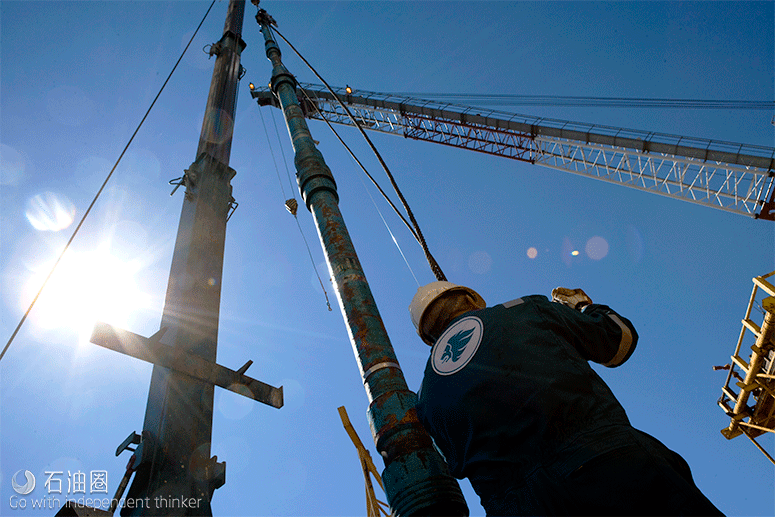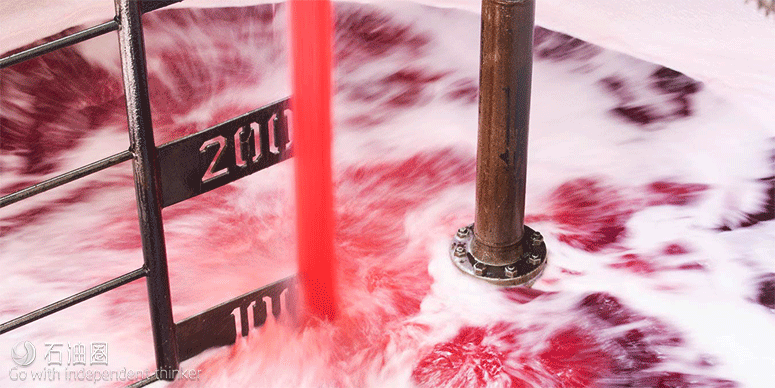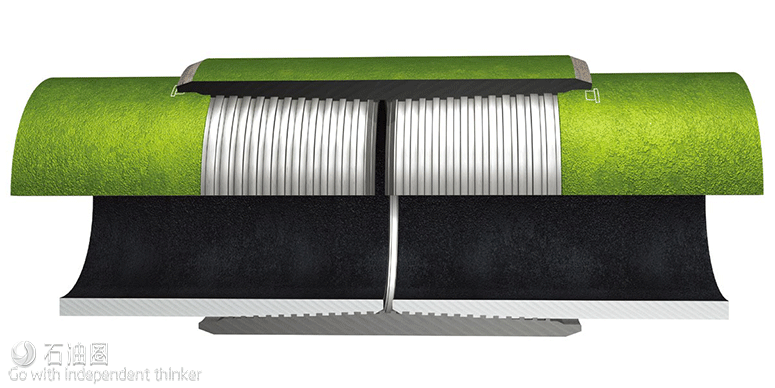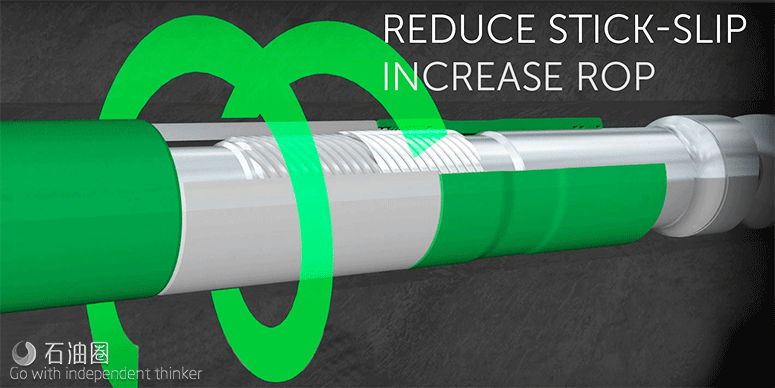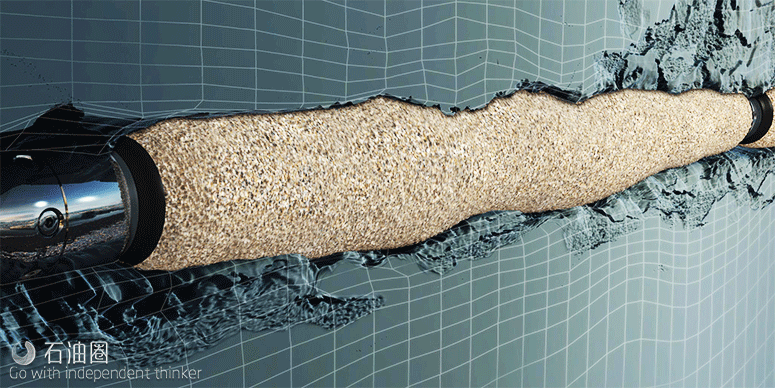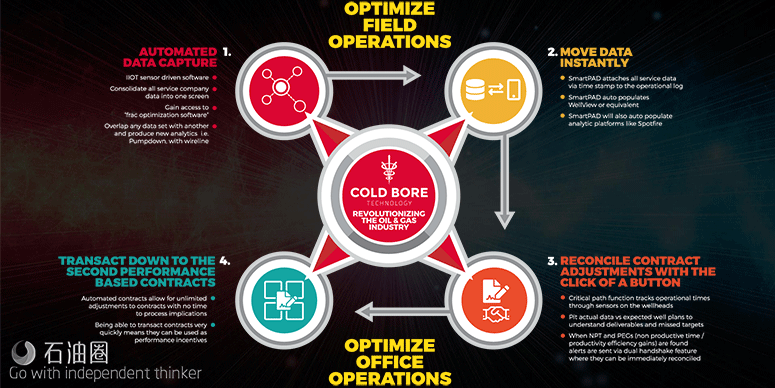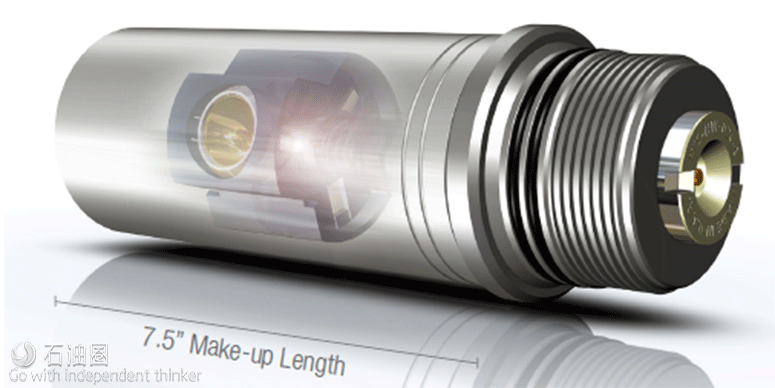System provides a gravel and frac pack alternative
The GeoFORM conformable sand management system from Baker Hughes, a GE company (BHGE), offers an alternative to conventional sand control methods. The GeoFORM system uses a material that expands and conforms to complex well profiles, delivering a new level of sand control performance with fewer operational requirements. The GeoFORM system is run downhole like a sand screen, but it can be installed by a two-person crew and doesn’t require special pumping equipment or proppant, making it ideal for remote locations. When used in place of a gravel pack, the GeoFORM system can save one to three days of rig time per zone. The Geo- FORM system’s shape memory polymer offers 3-D filtration without the complexities of pumping sand slurry. Once activated, the GeoFORM material fills the annulus, filtering sand particles and stabilizing the wellbore. Its microscopic pore structure captures a wide range of particle sizes while remaining highly porous to maximize hydrocarbon flow.
System enables real-time monitoring and analysis of multiwell pad operations
Cold Bore Technology’s SmartPAD is the first Industrial Internet of Things sensor-based, remote completions operating system that enables real-time monitoring, tracking and analysis of multiwell pad operations. It is helping operators improve their efficiency, enhance their onsite safety and reduce their overall number of frac days, resulting in costs savings of hundreds of thousands of dollars per pad. The system integrates service company data such as coil, wireline, frac, flowback and other digital data on location and couples it with sensor- driven operational data provided directly from the wellhead to generate a critical path time line. Valve positions are also displayed in real time, which is a significant safety feature. The comprehensive tracking of every minute detail of the operations provides new insight, and the instantaneous visibility of the operations has helped clients avoid serious incidents, damaged equipment and hazardous situations.
Solution for gravel pack completions
DiverterPlus has recently developed the MicroVert+ and SolVert+ GP lines of degradable diverters specifically designed for use in wells completed with a gravel pack or other sand control completion methods. The particles exhibit a designed oblong geometry and elasticity that allows them to traverse the gravel pack and deposit on the formation face itself where they then encourage even distribution of injected fluids. The manufacturing process allows extreme control over particle size, so products are available for optimum performance in any size gravel pack. Density alteration and solvent resistant coatings allow for use in a variety of fluids, including the most aggressive asphaltene and paraffin treatments, while remaining suspended without the need for high velocity. The particles exhibit the hydrolysis behavior of Diverter- Plus’ other lines of diverter, meaning that with time, temperature and the presence of water, the particles will chemically convert into a liquid form.
Technologies designed to lower costs
At this year’s ATCE, Expro will highlight CoilHose, a light well circulation system that minimizes the loss of hydrocarbon production and lowers the overall cost of intervention. The compact system is rapidly deployed, saving both time and cost over standard coiled tubing operations. It delivers a suite of wire deployed intervention options for cased-hole application, digital and standard well configuration tooling and heavy-duty fishing. Expro also will present its new intelligent intervention technology, an autonomous wireline system for the removal of waxes, scales and other solids. This technology saves the operator significant manpower and support costs as well as minimizes the environmental impact and community disturbance with the reduction of wireline trucks.
In addition, the company will showcase its production surveillance services, which are delivered through downhole monitoring and surface multiphase measurement, helping maximize production from operators’ reservoirs, wells and assets.
Directional drilling system automates decision-making and execution
Helmerich & Payne Technologies will be showcasing an automated directional drilling solution following a systematic, logical, phased approach to automating both directional drilling decision-making and the execution of slides. Attempting to follow a predefined path, even the best, most experienced drillers struggle to properly compensate for multiple variables including motor yield variations, target uncertainty, deflections, tortuosity risks and more. Slide execution has historically been more of an art form than a science; automating this process combines the two. The system processes a higher volume of data in a faster amount of time, allowing for continuous realtime improvement with additional analysis not possible by a human alone. Automating both the decision-making and the execution leads to reduced drilling costs, safer and more consistent operations, higher hydrocarbon production potential and improved wellbore quality. On the pathway to autonomous drilling, automated sliding is a crucial building block as part of a holistic approach fleetwide.
7.5-in. perforating gun fires up to three shots on a single plane
Hunting’s H-2 Perforating System has eliminated common surface handling inefficiencies and downhole challenges that the oil field is faced with while maintaining the highest performance standards. The H-2 is the shortest perforating gun in the oil field. At just 7.5 in. in length, the H-2 can fire up to three shots on a single plane and requires no wiring or detonating cord. H-2 is ideal for perforating with high cluster count per stage where rig height is limited. In a recent Delaware Basin field trial with a major operator, H-2 set a record for the number of multiple-shot perforating guns pumped down into a horizontal well on wireline. H-2 was utilized to successfully run 45 perforating guns, in conjunction with a plug, in a single run.
Fluid with a high degree of emulsion stability overcomes drilling problems
Conventional water-based drilling fluids have simple formulations and at first glance appear to keep drilling fluid costs low. However, when using a closed-loop system, the costs of water supply and hauling excess fluid significantly increases fluid management costs. The standard method to manage fluid volume cannot be applied while drilling through salt because it causes extreme washout of the formation due to reduced salinity levels. Significant water flow or lost circulation events also require various density changes. M-I SWACO, a Schlumberger company, developed the FluxDril direct emulsion fluid to meet the requirements for drilling a gauge wellbore and handle high amounts of drilled solids while maintaining ROP. This fluid provides a high degree of emulsion stability and overcomes the typical drilling-related problems encountered: salt formations, water flows, sour gas and mud losses in depleted formations. The FluxDril fluid also has the ability to recover a significant portion of the emulsified base oil, which reduces the associated drilling fluid cost.
Ball-activated steam valve enhances SAGD completions
Installing steam valves along the tubing string in steamassisted gravity drainage (SAGD) completions improves steam distribution along the lateral for uniform reservoir coverage. The Packers Plus Inferno Ball-Activated Steam Valve builds on this enhancement by eliminating the need to use coiled tubing (CT) to open the valves, saving time and cost during completion operations. The Inferno Ball-Activated Steam Valve is installed in the closed position and the sleeves are initially shifted using degradable actuation balls. By using actuation balls, the well does not have to be killed—which unnecessarily cools the reservoir— to activate the valves. Following sleeve activation, the ball is then pumped out into the liner where it degrades. The ball-activated steam valves can be closed and reopened multiple times using a shifting tool. Packers Plus collaborated with an operator to deploy the Inferno Ball-Activated Steam Valve in Alberta’s oil sands, and after three consecutive successful field trial runs, the operator has installed the valves in seven additional wells.
Extreme torque solution for longer laterals
West Canadian operators are focused on gaining efficiencies in their operations, as lateral wells are getting longer and directional drilling is becoming more challenging. Tenaris offers its new threaded and coupled Tenaris- Hydril Wedge XP 2.0 connection to cover these encounters. As part of the TenarisHydril Wedge series, the Wedge XP 2.0 provides exceptional over-torque performance achieved by the robustness of the Wedge thread design and a pin-to-pin backup mechanism. In unconventional operations, this new generation of semi-premium connections has demonstrated its ability to reduce running times, decrease connection rejects rates and decrease the risk of pipe stuck in a hole, while optimizing performance. This case will demonstrate real field experience of how the Tenaris- Hydril Wedge XP 2.0 connection delivered under very demanding well conditions. When combined with the company’s direct mill-to-well solution, Rig Direct services, customers receive streamlined logistics, further enhancing supply chain management, technical and field services.
Diverter technology reduces the total number of bridge plugs within a wellbore
SlicFrac is Thru Tubing Solutions’ diverter technology that allows operators to reduce the total number of bridge plugs within a wellbore while maintaining the advantages of closer stage spacing and adding additional clusters. The risk of a preset plug can be drastically reduced, along with pump downtime, completion cost and resources associated for the corresponding wireline runs and subsequent mill-out work. Applying SlicFrac diversion technology between bridge plugs allows the operator to achieve maximum cluster efficiency while stimulating the entire stage, without leaving orphan clusters behind. This ensures a more consistent stimulation volume pumped into each perforation cluster, ultimately providing a more balanced treatment and reducing the probability of a runaway frac, which could potentially damage offset wells.
Downhole automation increases efficiency
An increasing number of wells in U.S. Permian fields are being drilled using the Tomax AST tool. The tool provides automation through a simple, downhole algorithm that balances the depth of cut versus the rate of change in reactive torque. The nominal results are 40% faster ROP and almost double footage. Reaction time is the key to explain this huge improvement. The AST stabilizes the cut within 20 ms. That is very fast compared to the minutes it takes to tune the drilling parameters upon alerts from the MWD system or other warnings. The prevention of system excitation through the fast reaction time almost eliminates peak loads and thus overheating of the PDC cutting edges. The cutting edges have an obvious effect on both speed and footage. An additional benefit is reduced vibration and risk of damages to other tools in the downhole suite.

 石油圈
石油圈
